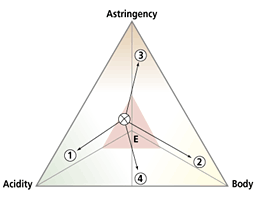EXTRACT 3/4
[Next extract]
Chapter 44 - Pairing Red Wines with Food
Question: "Do foods modify the balance of acidity, body and astringency in red wines?"
Rather than getting into a theoretical discussion, let's conduct a few exercises.
44.1. Food/Wine Exercise
Prepare your favourite dish and then choose a red wine that you like.
- Eat a small piece of bread.
- Now sip the red wine.
- Position the wine on the three-dimensional triangle: acidity/body/astringency (for example )
- Determine its IAP
- Eat some of the food.
- Sip the red wine again.
- Evaluate the wine and its IAP again.
Depending on the food and the wine, you will see one of the following changes:
- From to 1 = decreased astringency + increased acidity
- From to 2 = decreased astringency + increased body
- From to 3 = increased astringency
- From to 4 = the wine loses its structure
- From to E = sometimes the wine comes nearer to equilibrium (balance).
In those cases when the wine becomes more balanced (closer to E), you will perceive a certain fullness in the mouth that signals a perfect match. In almost all cases, the IAP value will be changed. In the cases when the wine becomes less balanced (i.e. farther from E), you can say that the food/wine match is not good.

44.2. Red Wines and Cheese?
Most drinkers in France and elsewhere think that red wines and cheese form a perfect pair!
Chapter 24. Testing White Wines with Cheese has probably already convinced you that the truth is much less obvious than most wine drinkers and cheese lovers think. The notion that red wines go with cheese was probably formulated decades ago when most red table wines were low in tannins.
The "ordinary" table wine of decades past was specifically produced to be low in tannins. Any techniques designed to extract tannins would have increased the ageing period and thus the cost of the wine. For these "jug" wines, the ONLY difference between reds and whites was their colour.
Thus, for generations, the French were accustomed to drinking "red-coloured white wines" with cheese!
Today, these low-tannin red wines are becoming less and less common. Now virtually all reds have some tannins and thus a definite astringency when young. As such, it is very hard to find a red wine that goes well with cheese.
A tannic red wine is always negatively
affected by cheese.
44.3. Exercises
Red Wine and Cow's Milk Cheese
Eat a small piece of bread.
Now sip the red wine.
Position the wine on the three-dimensional triangle: acidity/body/astringency (for example). Determine its IAP.
Eat some of the cheese.
Sip the red wine again.
Evaluate the wine and its IAP again. What's your assessment?
The Same Red Wine with Goat Cheese
Follow the same procedure. What's your verdict?
For comparison, you can open a bottle of white wine and go through the same exercise . Now what do you think?
Other Effects of Cheese on Red Wines
To add a little variety to your experiments and to enrich your tasting experience, you can:
- Test your favourite red wine with all the cheeses at your local cheese shop (there are more than 200 types of cheese in France alone!).
- Using the cheese family tree in Chapter 24.3, you can determine which cheeses pair up well with your wine.
- Try pairing a single type of cheese with the thousands of different wines of the world.
|